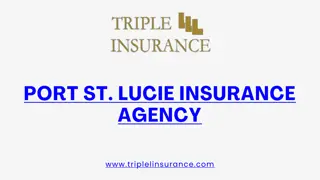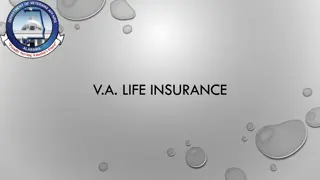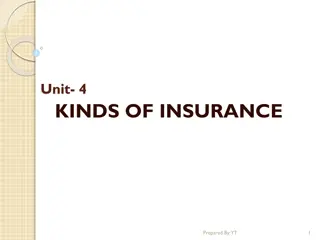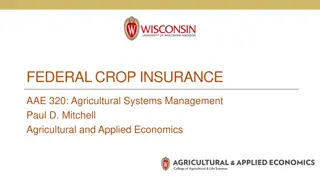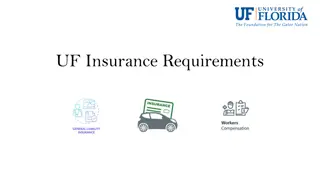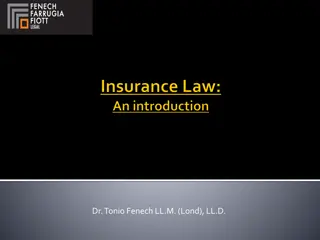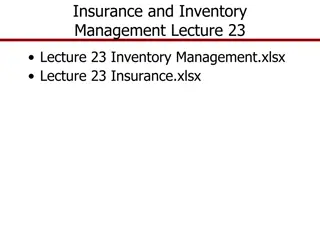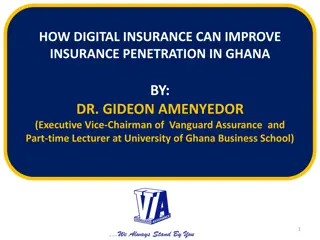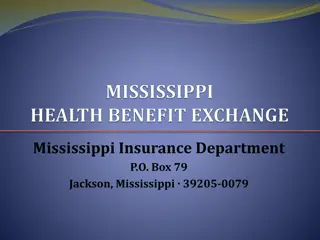BILA INSURANCE UPDATE
This article explores duty of fair presentation in insurance, the formation of insurance contracts, and the principle of utmost good faith through real-life cases and legal implications. Learn about key concepts and legal interpretations in insurance law.
Download Presentation

Please find below an Image/Link to download the presentation.
The content on the website is provided AS IS for your information and personal use only. It may not be sold, licensed, or shared on other websites without obtaining consent from the author.If you encounter any issues during the download, it is possible that the publisher has removed the file from their server.
You are allowed to download the files provided on this website for personal or commercial use, subject to the condition that they are used lawfully. All files are the property of their respective owners.
The content on the website is provided AS IS for your information and personal use only. It may not be sold, licensed, or shared on other websites without obtaining consent from the author.
E N D
Presentation Transcript
BILA INSURANCE UPDATE 16 November 2018 Professor Rob Merkin QC
DUTY OF FAIR PRESENTATION DUTY OF FAIR PRESENTATION Ageas Insurance Ltd v Stoodley 2018 WL 02024527 In May 2013 the Stoodleys took out a policy with Ageas on their vehicle. On 5 November 2013 Mrs S was involved in an accident while driving another car, and the claim was settled by other insurers. In May 2014 and again in 2015 the Ageas policy was renewed. He answered in the negative a question as to previous accidents in the past five years. On 20 December 2015 a BMW belonging to H and driven by S was involved in a motor accident which killed and seriously injured two other individuals.. Claims were brought against S In addition to Ageas liability was faced by Advantage, who had issued a separate policy to S on another vehicle, and Trinity Lane, the insurers of the BMW. Ageas discovered the November 2013 accident, and in June 2016 obtained an uncontested declaration of avoidance under section 152(2) of the Road Traffic Act 1988. Advantage sought permission to set aside the judgment on ground that there was no right to avoid under the Consumer Insurance Act 2012, but was denied. S had not acted with reasonable care in failing to answer truthfully a straightforward, clear and specific question. He had acted deliberately or recklessly, and Ageas had shown that but for the misrepresentation, it would not have entered into the contract, in that it had a policy of not renewing where there had been a claim 10,000. The fact that Ageas had returned the premium was immaterial.
FORMATION OF INSURANCE CONTRACTS FORMATION OF INSURANCE CONTRACTS QBE Insurance Ltd v Allianz Australia Insurance Ltd [2018] NZCA 239 In September 2009 the assured entered into a property policy with QBE for the period 4 September 2009 at 4pm to 4 September 2010 at 4pm . QBE declined renewal, and Allianz agreed to provide cover for the following year. The cover was agreed in conversations between the assured s broker and Allianz, and took effect on 4 September 2010. There was no mention of the time at which the Allianz cover incepted. On 19 November 2010 Allianz issued a policy schedule stating Effective date: 04/09/2010 and Expiry date: 4pm on 04/09/2011 . At 4.35am on 4 September 2010 the property was severely damaged by an earthquake. QBE paid the clam, but it sought contribution from Allianz on the basis that Allianz had been on risk at the same time. The Court of Appeal held that the schedule was to be disregarded as it had been issued after the agreement had been entered into, but that independently the parties had intended that the Allianz policy should come into force only when the QBE policy lapsed.
UTMOST GOOD FAITH I UTMOST GOOD FAITH I Ramsook v Crossley (Trinidad and Tobago) [2018] UKPC 9 The assured was covered under a motor policy up to the sum of $1.5 million. She was involved in a motor accident with the claimant. A claim was brought against her and the insurers took over the defence. They did so in reliance upon a policy term providing that: the company shall be entitled if it so desires to take over and conduct in the Insured s name the defence or settlement of any claim for indemnity or damages or otherwise and shall have full discretion in the conduct of any proceedings and in the settlement of any claim and the Insured shall give all such information and assistance as the Company may require. Judgment was given against her for $3.6 million. She learned of the proceedings and the judgment when the claimant sought to enforce the judgment. She sought to set aside the judgment against her on the ground that she had not been served with the proceedings. It was held that the insurers had acted with implied authority, although the PC commented that the clause: is not carte blanche to insurers to conduct proceedings in their own interests, without regard to reality or to their insured s account of events The insurers ought at least to have ascertained and considered her position, with a view to deciding whether it was appropriate simply to admit liability on her behalf. They ought also to have kept her informed about the continuing progress of proceedings, which would severely expose her financially.
UTMOST GOOD FAITH II UTMOST GOOD FAITH II Kilduff v Tower Insurance Ltd [2018] NZHC 704 The assured s property was seriously damaged by the Christchurch earthquakes on 22 February and 13 June 2011. The assured elected to repair, and it was common ground that Tower s obligation to provide indemnity was triggered by the claimants incurring liability to the repairers rather than actually making payment to the builders. A claim was made against Tower in September 2011, initially seeking $188,000. Tower obtained its own assessments. Tower made lower offers of payment in June 2014 and October 2014, but those were rejected. Gendall J held that the claimants were correct in asserting that additional underpinning of the two internal walls was required, and awarded a sum of $840,330.88, about midway between the competing estimates of the parties. The claimant also sought damages for: $24,339.13 for consultants fees incurred prior to April 2015, based upon Tower s own failures to produce proper scopes of work and price estimates until that time; and $10,000 for Ms Kilduff s emotional harm relating to alleged breaches by Tower of the implied insurance term that it would act in good faith, make claim decisions promptly and fairly, and settle the plaintiffs claim within a reasonable time. Gendall J held that there was no breach of the duty of good faith in respect of the former claim, but that there might be a case for recovery of the consultants fees subject to further submissions. However, he dismissed the latter claim. While the earlier offers of settlement by Tower were seriously inadequate, it had not been shown that Tower made them other than in good faith on the basis of information available to it. As regards delay, Gendall J was satisfied that although there had been substantial delay amounting to some seven years, that was not exclusively the fault of Tower. There were two other contributing factors: the unique situation faced by Tower of some 25,000 other claims against it resulting from the earthquakes, giving rise to strained capacity of the pool of experts; and the claimants own delays. Although Tower was not entirely blameless, it had not been shown on the balance of probabilities that damages for late payment should be awarded.
UTMOST GOOD FAITH III UTMOST GOOD FAITH III Equitas Insurance Ltd v Municipal Mutual Insurance Ltd [2018] EWCA Civ 991 Flaux LJ, sitting as a judge arbitrator, held that (i) MMI was entitled to spike each reinsurance claim to any applicable year of reinsurance cover of its choice; (ii) the duty of utmost good faith was limited, in a claims context, to a duty not to act dishonestly in connection with the making of a claim, and the exercise by MMI of an absolute contractual right to spike claims was not subject to any implied term or duty of utmost good faith; and (iii) MMI was correct in apportioning the loss for which the spiked reinsurance contracts were liable between the retentions and the various layers of reinsurance in each of the applicable years of reinsurance cover, on the basis of the independent liability method. Equitas sought permission to appeal under section 69 against these three rulings.. The CA held that permission to appeal would be granted. All three questions were of law, substantially affected the rights of the parties and were of general public interest. The rulings were each open to serious doubt.
SUBROGATION I SUBROGATION I Haberdashers v Lakehouse Contracts Ltd [2018] EWHC 558 (TCC) LEP entered into a Design and Build Contract with Lewisham Council under which LEP was required to carry out works to refurbish and extend the school s existing Victorian buildings. In turn LEP entered into a Design and Build Sub-Contract with Lakehouse for demolition and reconstruction work. Lakehouse employed a number of sub-contractors, including CPR under a Roofing Sub-Contract. CPR was to indemnify Lakehouse against liability in respect of damage to property due to the act or default of CPR, and CPR was required to insure against liability. LEP obtained Project Insurance which covered itself and all sub-contractors. There was a fire as a result of CPR s use of a blow lamp, causing substantial damage. Claims against Lakehouse were settled for 8.75 million, and were paid by the Project insurers. The insurers then brought subrogation proceedings against CPR for indemnity and contribution. Fraser J held that the proceedings succeeded despite CPR being a sub-contractor and thus identified as a party to the Project Insurance. (1) LEP had not acted as CPR s agent in taking out the Project Insurance so that CPR could not claim to be LEP s principal for the purpose. There could be agency only where the agent intended objectively to act in that capacity, and the contractual arrangements showed that CPR was intended to be liable to indemnify Lakehouse and to carry its own insurance. (2) The Project Insurance did not amount to a standing offer to any sub-contractor. CPR had agreed under the Roofing Sub-Contract that it would have its own insurance and therefore it never qualified as a sub-contractor entitled to be insured under the Project Insurance.
SUBROGATION II SUBROGATION II Prezzo Ltd v High Point Estates Ltd [2018] EWHC 1851 (Comm) The obligation of a landlord to insure the demised part of a building for the tenant did not extend to insuring the remaining parts of the building. Therefore, where a tenant negligently damaged the entire building, the landlord and, by extension, his insurers exercising subrogation rights could not sue for the demised part but could sue in respect of the remainder.
CONTRIBUTION I CONTRIBUTION I Foster v QBE European Underwriting Services [2018] NSWSC 440 F was employed by DCR, a labour hire company. He was hired to Reed, a sub- contractor for RMS, to work as a plant operator and labourer on a road construction project. f suffered injury on site on 15 December 2011, and commenced proceedings against Reed. There were two relevant policies in place on the date of the injury. Under the arrangements between RMS and Reed, RMS effected with Allianz a third party liability policy that covered RMS, Reed and all Subcontractors. The policy provided that where there were two or more insurance policies covering the liability, the Allianz Policy would operate as an excess policy . Reed had its own policy with QBE, against third party liability, which also provided that if there was other insurance in place then the QBE policy would operate as an excess cover only. The court was of the view that competing excess clauses were self-cancelling, on the principle in Gale v Motor Union Insurance Co [1928] 1 KB 359 and Weddell v Road Transport and General Insurance Co Ltd [1932] 2 KB 563.
CONTRIBUTION II CONTRIBUTION II RSA Insurance Plc v Assicurazioni Generali, 15 May 2018 M was employed by AWL from 1975 to 1986, when AWL was dissolved. In that period AWL was insured against employers liability as follows: October 1975 to June 1979, Aviva; June 1979 to March 1981, no insurer traced; April 1981 to March 1983, Generali; April 1983 to March 1985, no insurer traced; and April 1985 to September 1985, RSA. In 2010 M made a claim against RSA alleging that he had contracted mesothelioma by reason of exposure to asbestos by AWL. In January 2011 RSA settled the claim for 173,741, and payment was made in full in accordance with Fairchild v Glenhaven Funeral Services Lttd [2002] UKHL 22 and International Energy Group Ltd v Zurich Insurance UK Branch [2015] UKSC 33. RSA sought contribution of 32.4% of the payment from Generali, representing time on risk. Generali argued that the claim was time- barred and that RSA was required to exercise subrogation rights against other persons potentially liable for the exposure. The court held as follows. (1) A claim under an insurance policy was one for damages and not debt. That meant that contribution was determined in accordance with the Civil Liability (Contribution) Act 1978. Under section 10 of the Limitation Act 1978 the limitation period for a claim under the 1978 Act was two years, so the claim for contribution was statute-barred. (2) If there had been liability, RSA was not required to exercise subrogation rights before making its contribution claim.
CONFLICT OF LAWS CONFLICT OF LAWS Hofsoe v LVM [2018] CUECJ C-106/17 On 4 July 2014, a vehicle belonging to X, an individual domiciled in Poland was damaged in a traffic accident in Germany caused by a German national insured with LVM. On 12 July 2014 X entered into a hiring agreement for a replacement vehicle, and incurred costs of EUR3,465. LVM paid only EUR665. X assigned his rights to H, whose business consisted of pursuing assigned claims. H commenced proceedings in Poland in reliance on article 13(2) of the Brussels Regulation Recast, arguing that the right of a victim to sue liability insurers in the victim s home state extended to the victim s assignee. The CJEU held that article 13(2) was designed to protect only the weaker party, and a professional such as H was not entitled to the benefit of article 13(2) but instead had to sue LVM in the place of their own domicile in accordance with the basic domicile rule in article 4.
CLAIMS I CLAIMS I Wheeldon Brothers Waste Ltd v Millenium Insurance Company [2018] EWHC 834 (TCC) this was a claim by the assured following a fire in June 2014 at its waste processing plant near Manchester. The cause of the fire was identified as the result of the failure of the bearing in a conveyor leading to the conveyor belt burning and setting light to material around the foot of the conveyer. The policy contained conditions precedent and warranties. The court allowed the claim. (1) A condition precedent related to the storage of combustible materials within six metres, but the court was satisfied that the material that caught fire (metal) was not combustible, that it had not been stored (in that it had simply been deposited as result of the operations). (2) A warranty required combustible stock to be removed whilst the business was closed, but there was evidence that there was a system in place to comply with the warranty and that there was accordingly no breach. (3) The condition precedent requiring the assured to maintain all machinery in efficient working order and to retain records, but the evidence was that that had been done and that records although informal had been maintained. (4) A condition precedent requiring a good system of housekeeping to be in place had been complied with.
CLAIMS II CLAIMS II Manitowoq Platinum Pty Ltd v WFI Insurance Ltd [2018] WASCA 89 MPP s restaurant in Perth was fitted out by Boss in 2007 and 2008. A good deal of plumbing work was carried out. The work was defective in a number of respects, and in September and October 2013 MPP had to close the restaurant to effect repairs. MPP issued proceedings against Boss, and Boss in turn made a claim against its liability insurers WFI. Damages were assessed at $1,549,721.83. The question in the present case was whether WFI could rely upon any of the relevant policy exclusions. There were two such exclusions: an obligation to comply with legislation and Australian Standards ; and an obligation to take reasonable care to safeguard yourself and all property insured. At first instance the court held that the reasonable care clause was to be construed as meaning recklessness , and the obligation to comply with legislation was to be read subject to the reasonable care clause. On appeal it was held that the two obligations were distinct and that there was no recklessness limitation on the obligation to comply with legislation. On the facts, there was a breach of that clause and the insurers were not liable.
LIABILITY INSURANCE I LIABILITY INSURANCE I Notification of circumstances (1) The assured had to be aware of circumstances (2) A reasonable person in the assured s position would have known that the circumstances were likely/may give rise to a claim (3) The notification on its proper construction extended to the circumstances (4) There was a causal link between the circumstances notified and the claim made against the assured (5) A hornet s nest notification is permissible as long as the problems were sufficiently identifiable and known at the time of the notification
LIABILITY INSURANCE II LIABILITY INSURANCE II Euro Pools v Royal & Sun Alliance Insurance [2018] EWHC 46 (Comm) EPL installed a number of pools, but there were problems with the horizontal platforms that allowed the water depth to be varied, and with the booms which allowed vertical walls to be moved so as to divide the pools into swimming areas. Costs were incurred in correcting the issues. EPL had professional indemnity insurance for the year 30 June 2006 to 29 June 2007, and again for the year 30 June 2007 to 29 June 2008. The main question in this case was when there had been valid notification of circumstances. It was held that had been a valid notification of the circumstances relating to the platforms in February 2007, but that notification did not extend to the booms.
LIABILITY INSURANCE III LIABILITY INSURANCE III The Cultural Foundation v Beazley Furlong Ltd [2018] EWHC 1083 (Comm) In 2005 RM agreed with ASD to carry out design and construction administration of a school campus in Dubai. Sector A included an indoor athletics facility, Sector B included a theatre and music rooms. In 2006 and 2007 RM entered into consultancy contracts with ADNEC. Beazley insured RM under primary layer policies in the years 2008/09 and 2009/10, for US$10 million. Beazley was liable for defence costs in addition to the limit of indemnity but if the liability exceeded the sum insured then defence costs were to be reduced pro rata. There was excess layer cover for both years for US$35 million in excess of US$10 million. In late 2008 and early 2009 RM was failing to coordinate the work and designs. In March RM prepared Notification 923, identifying the co-ordination problem as a circumstance. In August 2009 concerns were raised about the suitability of the Field House columns and on 10 September 2009 RM issued Notification 953 in response to a request to prepare revised calculations. There were also problems in relation to Sector B, relating to acoustic designs for the music rooms and steelwork fabrication, and a letter before action was issued. Arbitrations were commenced. ASD obtained an award dated 31 May 2016 for US$8.6 million plus post-award interest, and ADNEC obtained an award dated 27 July 2016 for US$8.15 million plus post-award interest. Beazley paid the defence costs. RM became insolvent and ASD and ADNEC sought to recover the sums awarded to them in the arbitrations from the insurers under the Third Parties (Rights against Insurers) Act 1930. Held: (1) ASD s claim for defective design of the Sector A columns did not arise out of Notification 923 but instead notification 953. (2) ASD s claim for the acoustic works fell within Notification 923.(3) Beazley had paid by way of defence costs more than its proportionate share, and could set off the balance against the policy moneys. The set off was binding on claimants under the 1930 Act. (4) ASD and ADNEC could not recover post-award interest under the 1930 Act, as it did not relate to the liability insured under those policies.
LIABILITY INSURANCE IV LIABILITY INSURANCE IV Pacific International Insurance Co Ltd v Walsh [2018] NSWCA 9 D purchased her home in reliance on Walsh s building inspection report. She suffered mental harm when her daughter was injured by a fall caused by a defective balcony rail that Walsh should have identified. Walsh had two policies: General and Public Liability, excluding any liability arising of negligence in providing professional advice or services; and Professional Indemnity excluding cover for any liability, Costs and Expenses directly or indirectly caused by or arising out of or in any way connected with liability arising out of any Personal Injury or Property Damage. The NSWCA held that the exclusion did not extend to liability for injury or damage to third parties who relied upon advice or services provided by the assured. The exclusion excluded coverage for personal injury or property damage incidental to the company s business, eg, if one of Walsh s inspector negligently bumped into someone who then fell down a hole.
LIABILITY INSURANCE V LIABILITY INSURANCE V Weir Services Australia Pty Ltd v AXA Corporate Solutions Assurance [2018] NSWCA 100 Weir agreed with Phil Gold to refurbish on a semi-autogenous grinding mill. The circumferential weld installed by Weir disintegrated and the Mill failed. Phil Gold commenced arbitration proceedings seeking damages of US$68 million. In December 2015, before the conclusion of the arbitration, the parties entered into a cap and collar agreement under which Phil Gold agreed that if it was successful in recovering damages from Weir, the amount would be capped at US$10,725,000 (the cap) in consideration for Weir agreeing to pay Phil Gold a minimum fixed amount of US$2,000,000 whatever the outcome of the arbitration proceedings (the collar).The award dismissed Phil Gold s claim. Weir paid US$2,000,000 and sought to recover that payment and defence costs from its liability insurers. (1) There was no liability for the collar. Weir was not liable to Phil Gold by reason of the arbitration award, and its only liability was assumed. (2) There was an occurrence leading to property damage. Occurrence was defined as an event ... including continuous or repeated exposure to substantially the same general conditions , and the occurrence was the exposure of the weld to the cyclic loading forces or defective workmanship. (3) The exclusion for rendering Professional Services applied. Weir s core task under the contract was to conduct the mechanical refurbishment , which involved the professional activity of the provision of engineering services. It was not appropriate to dissect the task into each service provided. The definition of professional was wider than had traditionally been thought. (4) The product defect exclusion applied. The exclusion applied to Property Damage to Your Products if such Property Damage is attributable to any defect in Your Product once it had been repaired or serviced and left Weir s possession. The product was the mill, it had left Weir s possession and it subsequently suffered damage.
LIABILITY INSURANCE VI LIABILITY INSURANCE VI Travelers Insurance Company Ltd v XYZ [2018] EWCA Civ 1099 Transform supplied breast implants obtained from PIP in France, to customers. The implants had a propensity to rupture, and many did so. Proceedings by 623 claimants were brought against Transform and a Group Litigation Order was made in April 2012. Four sample cases were selected from the 623 in the Group, and all of the others were stayed. Transform refused to confirm its insurance position, but provided a witness statement stating had adequate insurance to fund its participation in the litigation. In fact the policy with Travelers covered only 197 of the claims, and the remaining 426 claims (mainly the worried well ) were uninsured. The shortfalls in policy coverage were not disclosed until May 2014. In June 2015 the 197 claims falling within the policy were settled and costs paid, but the remaining 426 claims were not paid. The 426 claimants obtained judgment in March 2016. The Court of Appeal held that Travelers should pay the costs of the 426 claimants. (1) The earlier cases did not lay down criteria for the exercise of discretion, and the correct principle was that where a non-party not merely funded the proceedings but substantially also controlled or benefited from them, justice ordinarily required that, if the proceedings fail, he would pay the successful party's costs. (2) The present facts were exceptional. Travelers funded and stood to benefit from defending the proceedings, and justice required that Travelers should pay the successful party s costs. A party who sought benefits had to accept the burdens. (3) The failure to disclose was one of the reasons that the costs had been incurred by the claimants whose claims were uninsured. (4) Travelers expectation must have been that it would have been liable for the costs of an unsuccessful defence, so there was no reason to anticipate that an adverse ruling in the present case would have any impact on the insurance market.
LIABILITY INSURANCE VII LIABILITY INSURANCE VII Onley v Catlin Syndicate Ltd [2018] FCAFC 119 A D&O policy provided that defence costs were payable up to the point at which illegal or improper conduct was proved or admitted. The assured was accused of tax fraud, but the insurers avoided the policy for non-disclosure of misappropriation of funds, the very matter to which the charges related. held that the insurers were entitled to rely upon their defence of non-disclosure. The court held that the defence costs clause did not purport to limit any right of avoidance. The clause was not deprived of effect because it remained applicable to criminal and dishonest conduct arising after the policy had incepted. Further, there was no breach of the duty of utmost good faith in relying on the defence.
AGGREGATION I AGGREGATION I Spire Healthcare Ltd v Royal & Sun Alliance Insurance Plc [2018] EWCA Civ 317 The assured faced 708 complaints alleging medical negligence on the part of a surgeon working at its hospitals between 2004 and 2011. 86 of those had resulted in legal proceedings. The assured had a combined liability insurance policy, and section 4 covered medical negligence. The schedule to the policy stated that the sum insured any one claim was 10 million, with a total sum of 20 million being payable for all damages costs and expenses arising out of all claims . Spire had to make a contribution towards the losses, amounting to 25,000 each and every claim , capped at 750,000. Proviso 5A stated: The total amount payable ... in respect of all damages costs and expenses arising out of all claims ... attributable to one source or original cause ... shall not exceed the Limit of Indemnity stated in the Schedule . Proviso 5A stated: the total amount payable ... in respect of all damages arising out of all claims ... irrespective of the number of sources or original causes of such claims shall not exceed the appropriate Limit of Indemnity stated in the Schedule . The Court of Appeal, upholding the trial judge s rulings in declaratory proceedings, held that Proviso 5A was an aggregation clause, which capped the limit of indemnity for linked claims at 10 million. Proviso 5B provided a higher cap, but that applied to all claims, whether or not linked.
AGGREGATION II Bank of Queensland Ltd v AIG Australia Ltd [2018] NSWSC 1689 The Bank operated Money Market Deposit Accounts (MMDAs) for its clients. 192 clients appointed SFP as their financial planner, and SFP arranged MMDAs for them. Between March 2004 and January 2013 funds were withdrawn from the MMDAs by SFP without proper client authorisation.. The 192 account holders sought to recover their losses from the Bank, alleging that funds had been released on the strength of emails and suspicious activity had not been investigated. The account holders formed a Group for the purposes of representative proceedings, and each signed a Class Member Registration Form setting out the various transgressions of the Bank and seeking compensation. A settlement was reached in May 2018 under which the Bank was to pay $6 million to the Group. The Bank s liability policy had a deductible of $2 million for each and every claim . A Claim was defined as either: (i) any suit or proceeding brought by any person against an Insured ; or (ii) any demand from any person that it is the intention of the person to hold and insured responsible for the results of any specified Wrongful Act. The term Wrongful Act meant any act or error or breach of duty or omission or conduct . The aggregation clause stated that all Claims arising out of, based upon or attributable to one or a series of related Wrongful Acts were deemed to be a single Claim. The Court held that the claims could not be aggregated and that there were 192 separate claims. (1) Although a representative action using one named claimant was only one suit or proceeding for the purpose of limb (i) of the definition of Claim , each member of the group had, by signing a Class Member Registration Form , made a separate Claim in the form of a demand for compensation. (2) Alternatively, claims were to be aggregated into a single claim if they were arising out of, based upon or attributable to one or a series of related Wrongful Acts , and the wrongful Acts in the present case were the unauthorised withdrawals, but they did not constitute a series of related acts because there was no interconnection between them: they were all carried out at different times, and while they were similar they were not a series .
PROPERTY INSURANCE I PROPERTY INSURANCE I Xu v IAG New Zealand Ltd [2018] NZCA 149 The Barlows home in Christchurch was insured by IAG under a Home Insurance policy under which, in the event of loss or damage, the basic coverage was for the cost of restoring [your home] to a condition as nearly as possible equal to its condition when new. If the home was not restored, the sum payable was the lesser of the amount of damage or estimated restoration costs. Condition 2 provided that: Where a contract of sale and purchase of your Home has been entered into the purchaser shall be entitled to the benefit of this Section. The house was damaged in the earthquakes in 2010 and 2011. In February 2015 the Barlows sold their property to the claimants for $217,000 and assigned their rights under the IAG policy. The claimants sought to recover rebuilding costs of $353,888 from IAG. The Court of Appeal rejected the claim. (1) The indemnity for repair costs was personal to the assured and could not be assigned. (2) Condition 2 referred only to situation where there was damage in the period between contract and conveyance.
PROPERTY INSURANCE II PROPERTY INSURANCE II Contact (Print and Packaging) Ltd v Travelers Insurance Co Ltd [2018] EWHC 83 (TCC) CPP purchased a printing press in 1997. It was installed in 1998 until a catastrophic failure on 17 April 2013, by reason of broken teeth in the gears. CCP used its other press until the purchase a second-hand replacement from BBR in November 2013 at a cost of 725,000 with an allowance of 120,000 by way of part exchange for the damaged press. CPP s insurance covered material damage and business interruption: subsidence was an insured peril, but defective workmanship was excluded. The Court allowed CPP s claim for the purchase of the replacement press but disallowed the bulk of the claim for business interruption. (1) The choice between causes was not binary, and there was always the possibility that there was insufficient evidence to show what the cause was. In the present case, there was a likelihood that subsidence was the proximate cause. (2) The design was not defective. Although negligence was irrelevant to a finding of defective design, the mere fact that something did not work did not mean that it was defective. In the present case the design was in accordance with that generally used in the UK and it was not defective. (3) The sum recoverable had to be assessed at the date of the loss. At that time it was reasonable for CCP to purchase a replacement second-hand press, given that it was not an option to purchase a new one and there was a strong risk that the press itself could not be repaired. The fact that the press was in fact repaired and resold by BBR did not affect the matter. (4) Although CCP s loss of gross profit in the indemnity period was 362,034, only some 18,900 could be attributed to the failure of the press. It was necessary to adjust the gross profit for the indemnity period by reference to trends, and there was evidence that CCP s fortunes had declined, that it had been able to meet orders from the remaining press despite being without the main press and that the loss of three customers was unconnected to the failure.
MARINE INSURANCE I MARINE INSURANCE I Sveriges Anfgartygs Assurans Forening v Connect Shipping Inc [2018] EWCA Civ 230 The vessel Renos was insured for US$12 million under a marine policy, and a further US$3 million under an increased value policy. The vessel was damaged by fire on 23 August 2012. The assured gave a notice of abandonment and claimed that the vessel was a constructive total loss, whereas the insurers asserted that there was a partial loss only. The Court of Appeal, upholding Knowles J at first instance, held that there was a constructive total loss. (1) The assured had not elected not to abandon the vessel. (2) The notice of abandonment was given with reasonable diligence after the receipt of reliable information about the loss, in accordance with section 62(3) of the Marine Insurance Act 1906. (3) Under section 60 of the 1906 Act, as modified by the clause 19 of the Institute Time Clauses - Hulls 1983, there was a constructive total loss if the cost of repair would exceed the insured value. There was no basis for limiting the relevant costs to those incurred after the notice of abandonment: Helmville Ltd v Yorkshire Insurance Co Ltd (The Medina Princess) [1965] 1 Lloyd's Rep 361, to the contrary, would not be followed. Pre-notice of abandonment salvage costs were thus to be taken into account. (4) Post-notice of abandonment repair costs included a contingency of 10 per cent to take account of the many matters that could not in advance be determined with precision. (5) The costs incurred in employing a tug, employing agents, surveyors and consultants, and preserving the machinery, were recoverable under the suing and labouring clause.
MARINE INSURANCE II MARINE INSURANCE II Engelhart CTP (US) LLC v Lloyd's Syndicate 1221 [2018] EWHC 900 (Comm) In April 2015 the claimant agreed to purchase 7000 MT of copper ingots from WG cif China, subsequently amended to 9000 mt. The first shipment of 7000 mt arrived without incident, but when the containers for the second shipment were opened they were found to contain slag of nominal commercial value. All of the shipping documents were fraudulent. The claimant sought indemnity under a Marine Cargo and Storage open cover policy on goods and/or merchandise and/or cargo and/or interest of all descriptions and the risks included leakage and/or shortage and/or difference in weight and/or difference in volume as is appropriate howsoever arising. The policy also had a Container clause stating that: It is agreed that this Insurance contract is also to pay for shortage of contents and a Fraudulent Documents clause stating that: This insurance contract covers physical loss of or damage to goods and/or merchandise insured hereunder through the acceptance by the Assured and/or Shippers of fraudulent documents of title. Sir Ross Cranston held that the policy did not respond to the loss. (1) An all risks marine cargo insurance covered loss of or damage to property, but in the present case the losses were economic losses due to the acceptance of fraudulent documents in the expectation that they covered physical goods. Broader words were required if the policy was to cover paper losses. (2) The Container clause did not assist the claimant. It did not apply where there had been no goods in the first place. (3) The Fraudulent Documents clause expressly provided cover for a physical loss of goods through acceptance of fraudulent documents of title, but there was no physical loss in the present case.
MARINE INSURANCE III MARINE INSURANCE III Navigators Insurance Company Ltd v Atlasnavios-Navegacao LDA [2018] UKSC 26 The B Atlantic was insured under a war risks policy commencing 1 July 2007. Insured perils included: capture seizure arrest restraint or detainment, and the consequences thereof or any attempt thereat (clause 1.2); any terrorist or any person acting maliciously or from a political motive (clause 1.5); and confiscation or expropriation (clause 1.6). Excluded from cover was arrest by reason of infringement of any customs or trading regulations (clause 4.1.5). In August 2007 the vessel took on a cargo of coal in Venezuela. During an underwater inspection on 13 August 2007, divers discovered three bags of cocaine weighing 132 kg strapped to the vessel's hull. It was assumed that this was the work of a drug cartel. Under Venezuelan law the concealment of drugs constituted a criminal offence and any vessel would be confiscated. The master and second officer were in August 2010 convicted and sentenced to nine years imprisonment. The vessel itself was confiscated. The Supreme Court denied recovery. (1) A person acting maliciously was confined to situations involving spite or ill-will against property or persons, but in the present case there was no such motive. There was no insured peril. (2) If that was wrong, the loss was proximately caused by infringement of customs regulations and the exclusion therefore applied.
MARINE INSURANCE IV Mamancochet Mining Ltd v Aegis Managing Agency Ltd [2018] EWHC 2643 (Comm) ML procured a marine insurance cargo policy on two cargoes of steel billets from Russian to Iran in August 2012. The cargoes were stolen at some time between 22 September 2012 and 7 October 2012, and a claim was made under the policy at some point after 8 March 2013. There were 30 subscribing insurers to the policy. They did not deny the validity of the claim as a matter of principle, and 19 of them duly paid. However, the remaining 11 subscribers relied upon the Sanction Limitation and Exclusion Clause in the policy under which no insurer was liable to pay any claim or provide any benefit hereunder to the extent that the provision of such cover, payment of such claim or provision of such benefit would expose that (re)insurer to any sanction, prohibition or restriction under United Nations resolutions or the trade or economic sanctions, laws, or regulations of the European Union, United Kingdom or the United States of America. Nine of the subscribers, all US companies, relied upon sanctions imposed by the US and the EU, the remaining two subscribers relied solely on EU sanctions. Proceedings were issued on 22 May 2018. The dispute arose by reason of the facts that: when the policy was taken out and when the loss occurred there were no sanctions in place; by the time the claim was made in March 2013 there were US and EU sanctions in place; the sanctions were lifted in January 2016; and the sanctions were re-imposed by the US but not the EU with effect from 4 November 2018. The question was whether payment before 4 November 2018 exposed the insurers to sanctions. Teare J held that the clause did not give the insurers a defence. (1) The policy was to be construed as meaning that a defence arose only if there was an actual contravention of sanctions by the making of a payment, and that the clause did not extinguish the insurers liability once a sanction had been imposed but merely applied to the obligation to pay, so the only question was whether US or EU sanctions were in force in the period leading up to 4 November 2018. (2) The US provisions properly construed meant that payment of claims before 4 November 2018 was not prohibited. (3) The EU provisions contained nothing to prevent payment after the lifting of the sanctions in January 2016.
BROKERS I BROKERS I Avondale Exhibitions Ltd v Arthur J Gallagher Insurance Brokers Ltd [2018] EWHC 1311 (QB) Avondale, owned by Mr Watkins, carried on the business of the manufacture and erection of exhibition stands. The stands were insured by QBE Insurance under a Commercial Combined Insurance for the years 2010-2013. On 26 August 2012, during the currency of the final policy, there was a fire at Avondale s premises, causing serious damage to the premises and destroying the stock. Following investigations, QBE declined cover and purported to avoid all three policies. QBE relied upon non-disclosure of Mr Watkin s criminal convictions: racially aggravated harassment, alarm or distress; failing to provide a specimen of breath; obstructing a constable; and assault. The Court dismissed a damages claim against the brokers. (1) Mr Watkins had not informed the brokers of the convictions. (2) The brokers were not obliged to give an oral warning of the duty to disclose convictions, and there had been ample warnings in the documentation, which was not unduly lengthy or dense. Further Mr Watkins was as savvy as an ordinary businessman .
BROKERS II BROKERS II Pakeezah Meat Supplies Ltd v Total Insurance Solutions Ltd [2018] EWHC 1141 (Comm) PML operated an Asian food supermarket in Bradford. PML was one of a number of companies, including PGL, PSL and HPL, operated by members of the Ul-Haq family. In April 2012 PGL, PML and PSL all went into administration, and in May 2012 a receiver was appointed in respect of HPL. The premises and business were transferred to PIRL. The premises were insured under a property and business interruption policy broked by the defendant. On 18 July 2013 there was a fire. The insurers avoided the policy on the grounds that PIRL had misrepresented the capacity of the oil fryers in use at the premises and that the claimant had failed to disclose that its directors had been the officers and/or principals of various companies that had got into financial difficulties. The Court allowed a claim against the brokers. (1) Mr Ul-Haq was unaware that the matters in question had to be disclosed. He had no understanding of insurance matters and relied upon the defendant s advice. (2) Had the defendant asked proper questions, PIRL would have provided accurate information. (3) The financial history of the individuals who controlled PIRL would not have made PIRL uninsurable. There was, however, a possibility that the insurers might not have insured because of the frying equipment, and damages would be reduced by 25% to take into account that possibility. (4) The point that PIRL arguably did not have insurable interest was not one that would have been relied upon by Milburn, so there was no independent ground upon which the claim against Milburn would have been defeated.
BROKERS III BROKERS III Dalamd Ltd v Butterworth Spengler Ltd [2018] EWHC 2558 (Comm) Doumac carried on a waste recycling business from premises in Cheshire, owned by Widnes. Doumac was insured with XL under a policy placed by BS brokers against damage and business interruption. BS placed buildings insurance for Widnes with Aviva . The Aviva policy was renewed in March 2012; an External Storage Condition required all waste to be stored more than 10 metres from the premises. On 31 July 2012 Doumac became insolvent and its business was transferred to JLS. BS renewed the XL policy in August 2012, and informed XL that Doumac had reformed as JLS, and was not told of the insolvency. A fire occurred on 21 October 2102. Aviva denied liability for breach of the External Storage Condition; and misrepresentation as to the demise of Doumac. XL avoided its policy for non-disclosure of: warnings from HSE, EA and and the Fire and Rescue Service regarding the storage of waste material; two small fires in 2010 and 2011; and the poor state of repair of the buildings. In 2014 JLS and Widnes assigned their rights to to Dalamd for an initial 1000. Proceedings were not brought against the insurers, and instead Dalmd claimed against BS. Butcher J held as follows. (1) There had been a valid assignment of rights to Dalamd: payment of the initial consideration was not a condition precedent to validity. (2) BS was in breach of duty regarding material non-disclosure: (a) it failed to inform Aviva of Doumac s insolvency; (b) it failed to advise Doumac that the amount of waste and the existence of previous fire incidents, which were material facts. (3) BS was in breach of duty by failing to advise Widnes as to the desirability of procuring loss of rent insurance, but there was no breach of duty as regards: (i) advice to JLS on the desirability of taking out business interruption insurance as the matter had been fully explained; and (ii) advice on the meaning and consequences of breach of the External Storage Condition, as Doumac was fully aware of it and the implications of its breach. (4) Where an assured commenced proceedings against a broker on the basis of a denial of liability by insurers, the assured had to prove on the balance of probabilities that the claim against the insurers would have failed. (5) The breaches of duty by BS in respect of disclosure would had given Aviva the right to avoid the policies, so BS were potentially liable, but Aviva would also have had the right to refuse to pay the claims by reason of breaches of the External Storage Condition for which BS were not responsible. The claim against BS for the losses under the Aviva policy thus failed. (6) The breaches of BS in respect of the XL policy had caused loss to Windsor, in that the matters would have been disclosed if Windsor had been warned.
MOTOR INSURANCE I MOTOR INSURANCE I Advantage Insurance Co Ltd v Stoodley [2018] EWHC 2135 (QB) LS was insured against liability by Advantage to drive his own vehicle, a Vauxhall Frontera. The policy also covered LS against while he was driving any other vehicle. On 20 December 2015 LS was driving a BMW owned by H, when it left the road and hit a tree. There were three passengers: H himself, and two others of whom one was killed and the other catastrophically injured. H was insured by Trinity Lane Insurance, under a policy that did not cover the liability of LS while driving the BMW. Claims were brought directly against Advantage under the European Communities (Rights against Insurers) Regulations 2002. Advantage initially sought to escape liability by relying upon a policy term requiring LS to report any accident and to co-operate with any investigation; it was alleged that LS was in breach of that term because he initially denied being the driver at all and was subsequently convicted of causing death by careless driving while over the prescribed limit for alcohol. Advantage subsequently served a notice of discontinuance, but the Court held that issue should go to trial. The Court ruled that the restriction in section 148(5) of the Road Traffic Act 1988, precluding reliance on a post-loss breach of contract by the insurer, meant that Advantage faced contractual liability to LS, and accordingly a claim could be brought by the victims against Advantage under the 2002 Regulations
MOTOR INSURANCE II Irving v Morgan Sindall Plc [2018] EWHC 1147 (QB) The claimant was involved in a road accident in which her car beame a total loss. She hired a replacement vehicle on credit pending payment by the defendant s insurers. There were delays in payment, and the hire period extended for over four months, leading to a bill of 20,109.60. The case proceded on the basis that the claimant was not required to pay the charges until her claim for damages had been concluded, but that she remained liable for the debt regardless of the outcome of the claim. The trial judge rejected the claim for damges for the credit hire costs on the grounds that there was no liability to pay credit hire charges and so no claim could be brought in respect of them, and that in any event the claimant was not impecunious. Both rulings were reversed by Turner J. (1) A defendant was not relieved from liability to reimburse credit hire charges simply because the claimant s liability for them was contingent on recovery from the defendant. (2) The claimant was on the facts impecunious, as purchasing a new car would have exposed her to financial risk should some other event occur.
MOTOR INSURANCE III Clark v Farley [2018] EWHC 1007 (QB) On Sunday 16 September 2012, a few weeks before his sixteenth birthday, Mr Clark was a pillion passenger on a motorcycle being driven by Mr Edmonds. The motorcycle collided with a motorcycle being driven by Mr Farley. Mr Clark, who was not wearing a crash helmet, suffered catastrophic brain injuries. The accident occurred on Mad Mile a footpath in a park that had signs banning motorcycles. Neither motorcycle was roadworthy and both were dangerous and uninsured. The Motor Insurers Bureau denied liability under the Uninsured Drivers Agreement, claiming that Mr Clark was involved in a joint illegal enterprise with Mr Edmonds and Mr Farley so that his claim was defeated by the maxim ex turpi causa non oritur action. Yip J dismissed the defence. There was no joint enterprise. On the evidence, Mr Clark could not have known that the bike was likely to be ridden dangerously. A deduction of 40% would be made for Mr Clark s contributory negligence in not wearing a crash helmet.
MOTOR INSURANCE IV Farah v Abdullahi [2018] EWHC 738 (QB) C was injured when he was pushed by D s Ford Focus into the path of a Mercedes driven by an unidentified driver then run over by D s Ford Focus. The insurers of the Mercedes were identified, and they obtained a declaration under section 152 of the Road Traffic Act 1988 that they were entitled to avoid the policy for material non-disclosure. The question in the present proceedings was whether C could commence proceedings against the unidentified driver. It was held that the decision in Cameron v Hussain [2017] EWCA Civ 366, which permitted a claim against an unidentified driver who was covered by insurance, extended to the situation where the insurers had a possible defence under the policy, in that C could benefit from the action by securing a judgment that could be enforced either against the insurers or the Motor Insurers Bureau.
AND FINALLY Halliburton Co v Chubb Bermuda Insurance Ltd [2018] EWCA Civ 817 On 20 April 2010 there was an explosion and fire on the Deepwater Horizon oil rig. Claims were made against BP (the lessee), Transocean (the owner) and Halliburton (monitoring services). Both Transocean and Halliburton were insured against liability by Chubb under the Bermuda Form.. Both Transocean and Halliburton settled the claims against them, but Chubb refused to pay either claim. Halliburton commenced arbitration (reference 1) by appointing N as its arbitrator, and Chubb appointed P. The identity of the third arbitrator could not be agreed, and following a contested hearing Flaux J appointed M, Chubb's preferred candidate as the third arbitrator. In December 2015 M accepted appointment by Chubb in an arbitration brought by Transocean in relation to the same policy (reference 2). M did not disclose that appointment to Halliburton. In August 2016 M accepted appointment as a substitute arbitrator in another claim made by Transocean against a different insurer on the same layer of insurance (reference 3). That proposed appointment was also not disclosed to Halliburton. In November 2016 Halliburton learned of M's appointment in references 2 and 3, and wrote to M for an explanation as to why he had not disclosed his appointments. M replied that it had not occurred to him that he was under any duty to make disclosure. Halliburton then sought to have M removed under section 24(1)(a) of the Arbitration Act 1996 on the basis that his conduct gave rise to an appearance of bias. Popplewell J rejected the application, and his decision was upheld by the Court of Appeal. (1) The test for potential bias was whether a fair-minded and informed observer, having considered the facts, would conclude that there was a real possibility that the tribunal was biased. (2) There was no objection to an arbitrator accepting appointments in multiple references concerning the same or overlapping subject matter with only one common party, so there was no apparent bias on that ground. (3) Disclosure should be given of facts and circumstances known to the arbitrator which would or might give rise to justifiable doubts as to his impartiality. In the present case M should have disclosed the Chubb appointments to Halliburton, but his failure to do so did not automatically mean that he should be removed. The question was whether the failure to disclose, combined with other factors, would give the fair-minded and informed observer a basis for a reasonable apprehension of lack of impartiality. In the present case the failure to disclose was accidental and the degree of overlap was limited, so the fair-minded observer would not consider the failure to disclose to give rise to justifiable doubts as to impartiality.








